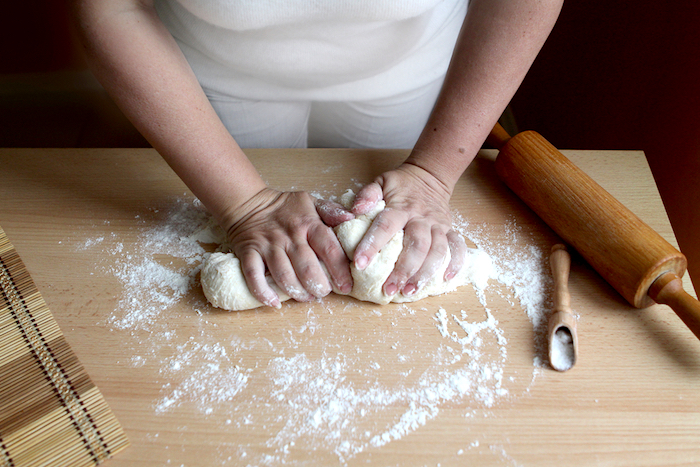It makes bread stretchy and it’s actually a darn good source of quality protein, but for many athletes gluten is a boogeyman to be feared. It’s forbidden on the Paleo diet, it’s forbidden on the Vertical Diet, it’s more-or-less forbidden on the ketogenic diet, and many popular influencers are linking it to inflammation, decreased cognition, and digestive problems. Now some polls estimate that up to 63 percent of people believe their health would improve if they stopped eating gluten.
But what is the science linking it to? Has gluten gotten worse for us, have our bodies gotten worse at processing it, is it both, or is the whole thing overblown? We spoke with a registered dietitian and looked at the research to get some answers.
- What Is Gluten?
- Are More People Becoming Sensitive to Gluten?
- Has Gluten Changed?
- Have We Changed?
- Should I Avoid Gluten to Be Safe?
Editor’s note: The content on BarBend is meant to be informative in nature, but it shouldn’t take the place of advice and/or supervision from a medical professional. The opinions and articles on this site are not intended for use as diagnosis, prevention, and/or treatment of health problems. Speak with your physician if you have any concerns or before beginning any new dietary regimen.

What Is Gluten, Anyway?
Gluten is a protein that’s found in wheat and wheat species and hybrids like rye, barley, and triticale. It’s what makes bread stretchy and it’s why gluten-free breads are usually quite crumbly and low in protein. Gluten is actually a combination of two proteins, prolamins and glutelins, and it comprises 75 to 85 percent of the protein in wheat. It’s a pretty high quality protein that’s rich in branched chain amino acids, which is why gluten-based meat substitutes like seitan are popular meat replacements in plant-based meals.
Are More People Becoming Sensitive to Gluten?
- Some estimate that celiac disease has risen by 400 percent in the last century
If you have celiac disease, you shouldn’t eat gluten. It triggers an immune response in the body that can cause a variety of symptoms depending on the severity of the condition, everything from indigestion to anemia to rashes to depression.
It’s estimated that between 0.7 and 1.4 percent of the world’s population has celiac disease, with women more likely to be afflicted. Some research has suggested that celiac disease has dramatically increased over the last century, perhaps as much by 400 percent.(1)(2)(3)(4) On top of that, some estimate that between 83 and 97 percent of people with celiac go undiagnosed or misdiagnosed with something like irritable bowel syndrome.(5)
Then there’s non-celiac gluten sensitivity (NCGS), which a lot more people claim to suffer from. It’s hard to say how common NCGS is since a lot of experts dispute its very existence.(6) But it refers to people who experience mild to severe symptoms similar to celiac disease but lack the antibodies and intestinal damage seen in people with the condition.(7)

Has Gluten Changed?
- The structure of gluten may have changed due to cross breeding and selective breeding
When asked why gluten is suddenly bad for us, one answer you sometimes hear is that wheat isn’t what it used to be.
Humans approach crops a little like we approach the animals we breed. A thousand years ago you’d have a hard time finding a dachshund or a chihuahua; we bred these animals to serve our purposes. We’ve done something similar with wheat: there’s evidence we’ve been storing it for at least thirty thousand years and cultivating it for at least ten thousand.(8)
There are a bunch of different kinds of wheat but the most common today is the aptly named common wheat, or bread wheat, which makes up 95 percent of the wheat produced. Throughout the years it underwent a lot of cross breeding and selective breeding to make it shorter and easier to farm, and in the ‘60s and ‘70s — during what’s called the Green Revolution — scientists produced wheat that’s way more resistant to disease and easy to grow with chemical fertilizers. There’s some evidence that the process also resulted in wheat with,
lower quality proteins, amino acid deficiencies, higher carbohydrates with unbalanced essential fatty acids, vitamins, and minerals.(9)
Some research has suggested that all the selective breeding has changed the structure of the gluten protein and made it easier to develop sensitivities to it.(10)(11) Other experts disagree with this theory, but it’s an interesting approach to the conundrum.

Have We Changed?
- Various factors may have changed the way we digest food in the last fifty years
Some theorize that the rise in gluten sensitivities could be because of the aforementioned changes in wheat, the increase in refined grains in our diets, or the increase of wheat in our foods (it’s not even uncommon in medications now).
Others suggest that we’re not eating a wide enough variety of foods, we’re not eating a wide enough variety of probiotic bacteria, or we’re not exposed to as many diseases as we used to be.(12) On the probiotics note, there’s also a theory that the increase in the amount of antibiotics we’re prescribed could play a role in decreasing the diversity of our gut bacteria and thereby affecting how well some people digest gluten.(13) A couple of studies have even found that getting infected with a ringworm can reduce or eliminate symptoms of gluten intolerance.(14) That’s one theory as to why people in developing countries have lower incidences of celiac disease.
All of these are just theories for the time being.

Should I Avoid Gluten Just to Be Safe?
- If you feel fine, you probably don’t need to avoid gluten
If the stats we cited previously are accurate, about 1 percent of people have celiac disease. If 90 percent go undiagnosed, that’s closer to ten percent. There’s not great data on how many people have non-celiac gluten sensitivity, but some suggests it’s in the ballpark of 0.5 to 13 percent of Americans.(15)(16) That’s a very, very broad range.
Still, it looks like 80 to 90 percent of people have absolutely no issue with gluten.
“There’s research that points to one in four self diagnosed individuals following a gluten free diet actually met the criteria for non-celiac gluten sensitivity,” says Hennis Tung, MS, RD, a New York-based dietitian and BarBend contributor. “Many people who think they have gluten intolerance probably don’t. There could be many other factors that could be contributing to the symptoms you’re experiencing, for example, many sources of gluten come from packaged and processed foods that aren’t agreeing with you, or it could be a function of gut health or other gut disorders like IBS.”
The fact that cutting out gluten means cutting out most processed foods and a good chunk of calories can explain why a lot of people feel better when they remove it from their diet.
“If there’s no indication you’ve tested positive and you don’t have any kind of gluten intolerance, it might be unnecessary because a lot of gluten free products are very expensive,” adds Tung.
Some research has even suggested that cutting out gluten for no reason might increase your risk of diabetes and heart disease.(17)(18) It’s not rock solid, but it may be because going gluten free makes you more likely to steer away from fiber-rich, heart healthy whole grains.(19)(20)

The Takeaway
If you have celiac disease, you already know not to eat gluten. If you feel weird after eating gluten (or you think you do), elimination diets are worth trying: you could try cutting out all sources of it while keeping in whole grain sources of the stuff — it might just be the processed foods causing you issues — and if you still don’t do well with gluten, go a month without it and see how you feel.
Remember also that bacteria seems to play a role, here. Fermented sourdough bread, for instance, is often easier to digest for people with gluten sensitivities, and some experience relief when they enrich their gut bacteria with probiotic supplements and fermented foods, which help to improve nutrient absorption and digestion.
Above all, speak to your physician if you’re concerned about any potential allergies.
Editor’s note: A previous version of this article stated that common wheat has undergone genetic modification. In fact, the changes were actually produced by selective breeding and cross breeding.
Featured image via Master1305/Shutterstock
References
1. Catassi C, et al. Natural history of celiac disease autoimmunity in a USA cohort followed since 1974. Ann Med. 2010 Oct;42(7):530-8.
2. Rubio-Tapia A, et al. Increased prevalence and mortality in undiagnosed celiac disease. Gastroenterology. 2009 Jul;137(1):88-93.
3. West J, et al. Incidence and prevalence of celiac disease and dermatitis herpetiformis in the UK over two decades: population-based study. Am J Gastroenterol. 2014 May;109(5):757-68.
4. Burger JP, et al. Rising incidence of celiac disease in the Netherlands; an analysis of temporal trends from 1995 to 2010. Scand J Gastroenterol. 2014 Aug;49(8):933-41.
5. Ianiro G, et al. Prior Misdiagnosis of Celiac Disease Is Common Among Patients Referred to a Tertiary Care Center: A Prospective Cohort Study. Clin Transl Gastroenterol. 2016 Jan 28;7:e139.
6. Reese I, et al. Non-celiac gluten/wheat sensitivity (NCGS)-a currently undefined disorder without validated diagnostic criteria and of unknown prevalence: Position statement of the task force on food allergy of the German Society of Allergology and Clinical Immunology (DGAKI). Allergo J Int. 2018;27(5):147-151.
7. Sapone A, et al. Divergence of gut permeability and mucosal immune gene expression in two gluten-associated conditions: celiac disease and gluten sensitivity. BMC Med. 2011 Mar 9;9:23.
8. Allaby RG, et al. Geographic mosaics and changing rates of cereal domestication. Philos Trans R Soc Lond B Biol Sci. 2017 Dec 5;372(1735).
9. Sands DC, et al. Elevating optimal human nutrition to a central goal of plant breeding and production of plant-based foods. Plant Sci. 2009 Nov;177(5):377-89.
10. van den Broeck HC, et al. Presence of celiac disease epitopes in modern and old hexaploid wheat varieties: wheat breeding may have contributed to increased prevalence of celiac disease. Theor Appl Genet. 2010 Nov;121(8):1527-39.
11. Rubio-Tapia A, et al. Increased prevalence and mortality in undiagnosed celiac disease. Gastroenterology. 2009 Jul;137(1):88-93.
12. de Sousa Moraes LF, et al. Intestinal microbiota and probiotics in celiac disease. Clin Microbiol Rev. 2014 Jul;27(3):482-9.
13. Mårild K, et al. Antibiotic exposure and the development of coeliac disease: a nationwide case-control study. BMC Gastroenterol. 2013 Jul 8;13:109.
14. Croese J, et al. Experimental hookworm infection and gluten microchallenge promote tolerance in celiac disease. J Allergy Clin Immunol. 2015 Feb;135(2):508-16.
15. Fasano A, et al. Nonceliac gluten sensitivity. Gastroenterology. 2015 May;148(6):1195-204.
16. Molina-Infante J, et al. Systematic review: noncoeliac gluten sensitivity. Aliment Pharmacol Ther. 2015 May;41(9):807-20.
17. Zong G, et al. Gluten intake and risk of type 2 diabetes in three large prospective cohort studies of US men and women. Send to Diabetologia. 2018 Oct;61(10):2164-2173.
18. Lebwohl B, et al. Long term gluten consumption in adults without celiac disease and risk of coronary heart disease: prospective cohort study. BMJ. 2017 May 2;357:j1892.
19. Wu H, et al. Association between dietary whole grain intake and risk of mortality: two large prospective studies in US men and women. JAMA Intern Med. 2015 Mar;175(3):373-84.
20. Seal CJ, et al. Whole-grain foods and chronic disease: evidence from epidemiological and intervention studies. Proc Nutr Soc. 2015 Aug;74(3):313-9.